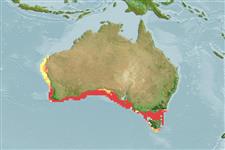Élasmobranches (requins et raies) (sharks and rays) >
Carcharhiniformes (Ground sharks) >
Triakidae (Houndsharks) > Galeorhininae
Etymology: Furgaleus: fur, Latin for thief (Whitley said “‘shark’ or villain”); galeus, Greek for weasel, an ancient name for sharks perhaps alluding to what some may have perceived as a weasel-like body or pointed snout [replacement name for Fur Whitley 1943, preoccupied by Fur Jones 1940 in Diptera] (See ETYFish); macki: In honor of British-born ichthyologist-ornithologist George Mack (1899-1963), National Museum, Melbourne, Australia (See ETYFish).
Eponymy: George Mack (1899–1963) was a British-born ichthyologist and ornithologist who emigrated from the UK to Western Australia (1919) and worked at the National Museum of Victoria, Melbourne (1923–1945) and at the Queensland Museum (1946–1963). [...] (Ref. 128868), visit book page.
More on author: Whitley.
Environment: milieu / climate zone / depth range / distribution range
Écologie
Can't connect to MySQL database (fbapp). Errorcode: Too many connections
